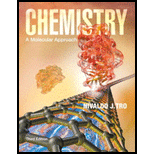
Chemistry: A Molecular Approach & Student Solutions Manual for Chemistry: A Molecular Approach, Books a la Carte Edition Package
1st Edition
ISBN: 9780321955517
Author: Nivaldo J. Tro
Publisher: PEARSON
expand_more
expand_more
format_list_bulleted
Concept explainers
Question
Chapter 10, Problem 4SAQ
Interpretation Introduction
Interpretation: The molecular geometry about nitrogen in the molecule given CH3NHCL3
Linear
Trigonal planar
Trigonal pyramidal
bent
Concept Introduction:
The Lewis structure of

Expert Solution & Answer
Want to see the full answer?
Check out a sample textbook solution
Students have asked these similar questions
Assign all the protons
PROPOSE REACTION MECHANISM FOR ACID-CATALYZED REACTION OF 3-PENTANONE WITH DIMETHYLAMINE
Assign all the protons
Chapter 10 Solutions
Chemistry: A Molecular Approach & Student Solutions Manual for Chemistry: A Molecular Approach, Books a la Carte Edition Package
Ch. 10 - Prob. 1SAQCh. 10 - Prob. 2SAQCh. 10 - Prob. 3SAQCh. 10 - Prob. 4SAQCh. 10 - Prob. 5SAQCh. 10 - Prob. 6SAQCh. 10 - Prob. 7SAQCh. 10 - Prob. 8SAQCh. 10 - Prob. 9SAQCh. 10 - Q10. Apply molecular orbital theory to predict...
Ch. 10 - Q11. Apply molecular orbital theory to determine...Ch. 10 - Q12. Which hybridization scheme occurs about...Ch. 10 - Q13. Which molecular geometry results when a...Ch. 10 - Prob. 14SAQCh. 10 - Prob. 15SAQCh. 10 - 1. Why is molecular geometry important? Cite some...Ch. 10 - 2. According to VSEPR theory, what determines the...Ch. 10 - 3. Name and sketch the five basic electron...Ch. 10 - 4. Explain the difference between electron...Ch. 10 - 5. Give the correct electron and molecular...Ch. 10 - 6. How do you apply VSEPR theory to predict the...Ch. 10 - Prob. 7ECh. 10 - Prob. 8ECh. 10 - 9. In valence bond theory, what determines the...Ch. 10 - 10. In valence bond theory, the interaction energy...Ch. 10 - Prob. 11ECh. 10 - Prob. 12ECh. 10 - 13. How is the number of hybrid orbitals related...Ch. 10 - Prob. 14ECh. 10 - Prob. 15ECh. 10 - 16. Name the hybridization scheme that corresponds...Ch. 10 - Prob. 17ECh. 10 - Prob. 18ECh. 10 - 19. What is a bonding molecular orbital?
Ch. 10 - 20. What is an antibonding molecular orbital?
Ch. 10 - 21. What is the role of wave interference in...Ch. 10 - Prob. 22ECh. 10 - 23. How is the number of molecular orbitals...Ch. 10 - 24. Sketch each molecular orbital.
a. σ2s
b.
c....Ch. 10 - Prob. 25ECh. 10 - Prob. 26ECh. 10 - Prob. 27ECh. 10 - Prob. 28ECh. 10 - Prob. 29ECh. 10 - 30. Write a short paragraph describing chemical...Ch. 10 - 31. A molecule with the formula AB3 has a trigonal...Ch. 10 - 32. A molecule with the formula AB3 has a trigonal...Ch. 10 - 33. For each molecular geometry, list the number...Ch. 10 - Prob. 34ECh. 10 - 35. Determine the electron geometry, molecular...Ch. 10 - Prob. 36ECh. 10 - 37. Which species has the smaller bond angle, H3O...Ch. 10 - Prob. 38ECh. 10 - 39. Determine the molecular geometry and sketch...Ch. 10 - Prob. 40ECh. 10 - Prob. 41ECh. 10 - Determine the molecular geometry about each...Ch. 10 - 43. Each ball-and-stick model shows the electron...Ch. 10 - 44. Each ball-and-stick model shows the electron...Ch. 10 - 45. Determine the geometry about each interior...Ch. 10 - Prob. 46ECh. 10 - Prob. 47ECh. 10 - Prob. 48ECh. 10 - Prob. 49ECh. 10 - Prob. 50ECh. 10 - Determine whether each molecule is polar or...Ch. 10 - Prob. 52ECh. 10 - 53. The valence electron configurations of several...Ch. 10 - 54. The valence electron configurations of several...Ch. 10 - 55. Write orbital diagrams (boxes with arrows in...Ch. 10 - Prob. 56ECh. 10 - 57. Write orbital diagrams (boxes with arrows in...Ch. 10 - Prob. 58ECh. 10 - 59. Which hybridization scheme allows the...Ch. 10 - Prob. 60ECh. 10 - Prob. 61ECh. 10 - 62. Write a hybridization and bonding scheme for...Ch. 10 - Prob. 63ECh. 10 - Prob. 64ECh. 10 - 65. Write a hybridization and bonding scheme for...Ch. 10 - Write a hybridization and bonding scheme for each...Ch. 10 - 67. Consider the structure of the amino acid...Ch. 10 - 68. Consider the structure of the amino acid...Ch. 10 - 69. Sketch the bonding molecular orbital that...Ch. 10 - Prob. 70ECh. 10 - 71. Draw an MO energy diagram and predict the bond...Ch. 10 - Prob. 72ECh. 10 - Prob. 73ECh. 10 - Prob. 74ECh. 10 - Prob. 75ECh. 10 - 76. Using the molecular orbital energy ordering...Ch. 10 - 77. Use molecular orbital theory to predict if...Ch. 10 - 78. Use molecular orbital theory to predict if...Ch. 10 - Prob. 79ECh. 10 - Prob. 80ECh. 10 - 81. Draw an MO energy diagram for CO. (Use the...Ch. 10 - Prob. 82ECh. 10 - 83. For each compound, draw the Lewis structure,...Ch. 10 - 84. For each compound, draw the Lewis structure,...Ch. 10 - 85. Amino acids are biological compounds that link...Ch. 10 - 86. The genetic code is based on four different...Ch. 10 - 87. The structure of caffeine, present in coffee...Ch. 10 - 88. The structure of acetylsalicylic acid...Ch. 10 - 89. Most vitamins can be classified as either fat...Ch. 10 - 90. Water does not easily remove grease from...Ch. 10 - Prob. 91ECh. 10 - Prob. 92ECh. 10 - 93. Bromine can form compounds or ions with any...Ch. 10 - 94. The compound C3H4 has two double bonds....Ch. 10 - Prob. 95ECh. 10 - Prob. 96ECh. 10 - Prob. 97ECh. 10 - 98. Indicate which orbitals overlap to form the s...Ch. 10 - 99. In VSEPR theory, which uses the Lewis model to...Ch. 10 - 100. The results of a molecular orbital...Ch. 10 - 101. The results of a molecular orbital...Ch. 10 - Prob. 102ECh. 10 - Prob. 103ECh. 10 - Prob. 104ECh. 10 - Prob. 105ECh. 10 - 106. Neither the VSEPR model nor the hybridization...Ch. 10 - 107. Draw the Lewis structure for acetamide...Ch. 10 - Prob. 108ECh. 10 - 109. Which statement best captures the fundamental...Ch. 10 - 110. Suppose that a molecule has four bonding...Ch. 10 - 111. How does each of the three major bonding...Ch. 10 - Prob. 112E
Knowledge Booster
Learn more about
Need a deep-dive on the concept behind this application? Look no further. Learn more about this topic, chemistry and related others by exploring similar questions and additional content below.Similar questions
- Assign all the carbonsarrow_forward9 7 8 C 9 8 200 190 B 5 A -197.72 9 8 7 15 4 3 0: ང་ 200 190 180 147.52 134.98 170 160 150 140 130 120 110 100 90 90 OH 10 4 3 1 2 -143.04 140. 180 170 160 150 140 130 120 110 100 90 CI 3 5 1 2 141.89 140.07 200 190 180 170 160 150 140 130 120 110 100 ៖- 90 129. 126.25 80 70 60 -60 50 40 10 125.19 -129.21 80 70 3.0 20 20 -8 60 50 10 ppm -20 40 128.31 80 80 70 60 50 40 40 -70.27 3.0 20 10 ppm 00˚0-- 77.17 30 20 20 -45.36 10 ppm -0.00 26.48 22.32 ―30.10 ―-0.00arrow_forwardAssign all the carbonsarrow_forward
- C 5 4 3 CI 2 the Righ B A 5 4 3 The Lich. OH 10 4 5 3 1 LOOP- -147.52 T 77.17 -45.36 200 190 180 170 160 150 140 130 120 110 100 90 80 70 60 50 40 30 20 10 ppm B -126.25 77.03 200 190 180 170 160 150 140 130 120 110 100 90 80 70 60 50 40 30 20 10 ppm 200 190 180 170 160 150 140 130 120 110 100 90 80 TO LL <-50.00 70 60 50 40 30 20 10 ppm 45.06 30.18 -26.45 22.36 --0.00 45.07 7.5 1.93 2.05 -30.24 -22.36 C A 7 8 5 ° 4 3 7.5 7.0 6.5 6.0 5.5 5.0 4.5 4.0 3.5 3.0 2.5 2.0 1.5 1.0 ppm 9 8 5 4 3 ཡི་ OH 10 2 7.5 7.0 6.5 6.0 5.5 5.0 4.5 4.0 3.5 3.0 2.5 2.0 1.5 5 4 3 2 that th 7 I 7.0 6.5 6.0 5.5 5.0 4.5 4.0 3.5 3.0 2.5 2.0 1.5 115 2.21 4.00 1.0 ppm 6.96 2.76 5.01 1.0 ppm 6.30 1.00arrow_forwardCurved arrows were used to generate the significant resonance structure and labeled the most significant contribute. What are the errors in these resonance mechanisms. Draw out the correct resonance mechanisms with an brief explanation.arrow_forwardWhat are the: нсе * Moles of Hice while given: a) 10.0 ml 2.7M ? 6) 10.ome 12M ?arrow_forward
- You are asked to use curved arrows to generate the significant resonance structures for the following series of compounds and to label the most significant contributor. Identify the errors that would occur if you do not expand the Lewis structures or double-check the mechanisms. Also provide the correct answers.arrow_forwardhow to get limiting reactant and % yield based off this data Compound Mass 6) Volume(mL Ben zaphone-5008 ne Acetic Acid 1. Sam L 2-propanot 8.00 Benzopin- a col 030445 Benzopin a Colone 0.06743 Results Compound Melting Point (°c) Benzopin acol 172°c - 175.8 °c Benzoping to lone 1797-180.9arrow_forwardAssign ALL signals for the proton and carbon NMR spectra on the following pages.arrow_forward
- 7.5 1.93 2.05 C B A 4 3 5 The Joh. 9 7 8 1 2 7.5 7.0 6.5 6.0 5.5 5.0 4.5 4.0 3.5 3.0 2.5 2.0 1.5 1.0 ppm 9 7 8 0.86 OH 10 4 3 5 1 2 7.5 7.0 6.5 6.0 5.5 5.0 4.5 4.0 3.5 3.0 2.5 2.0 1.5 1.0 ppm 9 7 8 CI 4 3 5 1 2 7.0 6.5 6.0 5.5 5.0 4.5 4.0 3.5 3.0 2.5 2.0 2.21 4.00 1.5 2.00 2.07 1.0 ppm 2.76arrow_forwardAssign the functional group bands on the IR spectra.arrow_forwardFind the pH of a 0.120 M solution of HNO2. Find the pH ignoring activity effects (i.e., the normal way). Find the pH in a solution of 0.050 M NaCl, including activityarrow_forward
arrow_back_ios
SEE MORE QUESTIONS
arrow_forward_ios
Recommended textbooks for you
 ChemistryChemistryISBN:9781305957404Author:Steven S. Zumdahl, Susan A. Zumdahl, Donald J. DeCostePublisher:Cengage Learning
ChemistryChemistryISBN:9781305957404Author:Steven S. Zumdahl, Susan A. Zumdahl, Donald J. DeCostePublisher:Cengage Learning ChemistryChemistryISBN:9781259911156Author:Raymond Chang Dr., Jason Overby ProfessorPublisher:McGraw-Hill Education
ChemistryChemistryISBN:9781259911156Author:Raymond Chang Dr., Jason Overby ProfessorPublisher:McGraw-Hill Education Principles of Instrumental AnalysisChemistryISBN:9781305577213Author:Douglas A. Skoog, F. James Holler, Stanley R. CrouchPublisher:Cengage Learning
Principles of Instrumental AnalysisChemistryISBN:9781305577213Author:Douglas A. Skoog, F. James Holler, Stanley R. CrouchPublisher:Cengage Learning Organic ChemistryChemistryISBN:9780078021558Author:Janice Gorzynski Smith Dr.Publisher:McGraw-Hill Education
Organic ChemistryChemistryISBN:9780078021558Author:Janice Gorzynski Smith Dr.Publisher:McGraw-Hill Education Chemistry: Principles and ReactionsChemistryISBN:9781305079373Author:William L. Masterton, Cecile N. HurleyPublisher:Cengage Learning
Chemistry: Principles and ReactionsChemistryISBN:9781305079373Author:William L. Masterton, Cecile N. HurleyPublisher:Cengage Learning Elementary Principles of Chemical Processes, Bind...ChemistryISBN:9781118431221Author:Richard M. Felder, Ronald W. Rousseau, Lisa G. BullardPublisher:WILEY
Elementary Principles of Chemical Processes, Bind...ChemistryISBN:9781118431221Author:Richard M. Felder, Ronald W. Rousseau, Lisa G. BullardPublisher:WILEY

Chemistry
Chemistry
ISBN:9781305957404
Author:Steven S. Zumdahl, Susan A. Zumdahl, Donald J. DeCoste
Publisher:Cengage Learning

Chemistry
Chemistry
ISBN:9781259911156
Author:Raymond Chang Dr., Jason Overby Professor
Publisher:McGraw-Hill Education

Principles of Instrumental Analysis
Chemistry
ISBN:9781305577213
Author:Douglas A. Skoog, F. James Holler, Stanley R. Crouch
Publisher:Cengage Learning

Organic Chemistry
Chemistry
ISBN:9780078021558
Author:Janice Gorzynski Smith Dr.
Publisher:McGraw-Hill Education

Chemistry: Principles and Reactions
Chemistry
ISBN:9781305079373
Author:William L. Masterton, Cecile N. Hurley
Publisher:Cengage Learning

Elementary Principles of Chemical Processes, Bind...
Chemistry
ISBN:9781118431221
Author:Richard M. Felder, Ronald W. Rousseau, Lisa G. Bullard
Publisher:WILEY
Stoichiometry - Chemistry for Massive Creatures: Crash Course Chemistry #6; Author: Crash Course;https://www.youtube.com/watch?v=UL1jmJaUkaQ;License: Standard YouTube License, CC-BY
Bonding (Ionic, Covalent & Metallic) - GCSE Chemistry; Author: Science Shorts;https://www.youtube.com/watch?v=p9MA6Od-zBA;License: Standard YouTube License, CC-BY
General Chemistry 1A. Lecture 12. Two Theories of Bonding.; Author: UCI Open;https://www.youtube.com/watch?v=dLTlL9Z1bh0;License: CC-BY